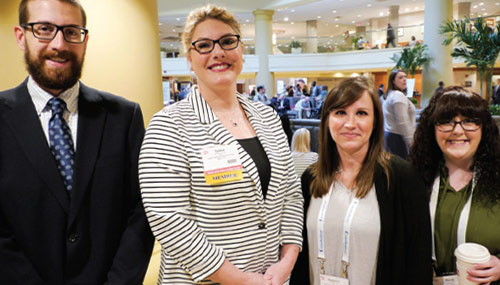Shifting stigma, overcoming opioids in rural Oklahoma
Naloxone training event in Stigler, Okla.
She fell to the floor, seizing, unresponsive, with jaw drooping and mouth wide open. All it took was a few moments; the patient had just entered the health center, and the receptionist beckoned for help. More calm and collected than frenetic, the health team mobilized. Donna Horton, a nurse practitioner of 30 years, directed her resident to check the bag the patient had brought in with her. Inside was a myriad of drugs prescribed by multiple providers. Based on this observation and the patient’s symptoms, Horton recognized the patient was experiencing an opioid overdose. She immediately administered naloxone, saving the woman’s life.
Horton was able to recognize the symptoms of an overdose and properly administer naloxone because of training she received earlier this year hosted by the Stigler Health and Wellness Center (SHWC). SWHC receives grant funding under the Rural Health Opioid Program (RHOP) administered by the Health Resources & Services Administration’s (HRSA) Federal Office of Rural Health Policy (FORHP). A federally qualified health center, SHWC uses the funds to increase access to substance abuse services and identify and treat community members with opioid use disorder (OUD), allowing them to begin the recovery process.
An example of excellence in Oklahoma
The people of tight-knit Stigler, Okla., demonstrate that size and rurality will not hinder them from improving the health of their community. This predominantly farming and mining community in the mountainous southeastern part of the state has 3,500 residents. Though the incidence of drug overdose fatalities due to opioids in Oklahoma is similar to the national average, the opioid-related overdose deaths among adults age 55 to 64 years is 18.2 fatalities per 100,000, which is higher than the national average (15.2).
Responding to this serious issue, SWHC, which serves the low-income and underinsured populations of six counties, is using its HRSA grant to provide community education, illustrate the scope of OUD, increase the capacity of providers to offer treatment for OUD, and purchase naloxone kits for distribution to the public.

.jpg?width=921&ext=.jpg)
(From left) Mike Blodgett, FORHP Rural Health Opioid Program coordinator, met with Stigler CEO Teresa Huggins, CFO Stephanie Long and board member Wanda Leathers in Washington, D.C., on March 29. (Photo Credit: Jim Haner, HRSA)
 (Left to right) Sarah Byrum, Cynthia Del Rosario, Donna Horton, and Kristina Lyons converged on a stricken patient in their health center — just weeks after receiving training on how to administer the lifesaving opioid-reversal drug naloxone.
(Left to right) Sarah Byrum, Cynthia Del Rosario, Donna Horton, and Kristina Lyons converged on a stricken patient in their health center — just weeks after receiving training on how to administer the lifesaving opioid-reversal drug naloxone.
“With the RHOP grant, we had to establish community education,” says Teresa Huggins, Stigler CEO. “So far we have had three sessions; [the city of] Stigler had 100-plus people show up. We didn’t anticipate that many people attending, and most of the people who showed up were lay people and community folk.”
Similarly, Sara Byrum, the health center’s pharmacist who conducted the naloxone training, says the people who attended the trainings were from all different walks of life: employees from Walmart, the school principal and faculty, police and EMS workers, and church members. SHWC has conducted a training in each of the six counties they serve and will continue to facilitate them upon request. A local volunteer firefighter asked SHWC to facilitate a training with their department after attending a presentation.
In a small town, it is extremely beneficial to have people from different strata of the community trained to administer a lifesaving intervention such as naloxone. However, this functional capacity building is especially valuable for the residents. According to Byrum, Stigler claims “some of the highest rates of deaths per 100,000 for opioid-related deaths in southeastern Oklahoma.” Byrum explains that initially there was a lot of resistance to prioritizing the community’s opioid-related issues, but now people are excited to learn. A shift in mindset is occurring from heavily stigmatized notions about addiction to people asking how they can become more engaged in overcoming the epidemic in their community.
One reason for this cultural shift is a progressive change in the state’s policies. In Oklahoma, legislation passed in 2013 authorizing the distribution of naloxone to trained family members and first responders. Prior to the policy change, anyone who was not a paramedic or licensed medical professional was not legally allowed to carry and administer the drug. In 2014, a legislative statute passed to allow purchase of naloxone without a prescription, provided the pharmacy or location has a standing order from a local physician.
SHWC’s Huggins also consistently engages with federal, state, and community leaders to learn more about, address, and overcome the challenges and barriers of the opioid epidemic. “I suggested that from the federal level, if they wanted to reach 27 million people who could potentially be a target audience, they needed to engage with [HRSA-funded] community health centers,” Huggins explains. “After all, we serve a population who are at high risk due to many factors contributing to addiction: low income, high ACE (adverse childhood experience) scores, uninsured, and patients with comorbidities are a large percentage of the patients we serve.”
These community-based drivers, policy changes, and activists have coalesced into a growing positive feedback loop in Oklahoma. With the need for change actualized in the conscience of the community, positive outcomes are growing efforts to extinguish the OUD epidemic that has run rampant for far too long.
A guiding hand
Stigler’s success story shows the tangible results of community-government collaboration. RHOP is just one FORHP program that addresses the opioid epidemic; the Rural Communities Opioid Response Program (RCORP) is another initiative that assists rural organizations in responding to the increasing prevalence of OUD in their communities.
RCORP focuses on reducing the morbidity and mortality associated with opioid overdoses in high-risk rural communities through multi-sector consortiums aiming to strengthen their organizational and infrastructural capacity. By focusing on prevention and treatment of substance use disorder, including opioid use disorder, RCORP benefits rural counties at the highest risk for substance use disorder.
With ample opportunities and funding from HRSA, rural communities and organizations have improved the health of their communities. The experience of SWHC serves as a model for rural communities with similar issues, as Stigler shows that mobilizing into a collaborative, dedicated, and hardworking unit to tackle public health issues can yield monumental results. When communities like Stigler enhance their strength by seeking out available resources, they too can save one more life, again and again.
Learn about effective community-based substance misuse treatment initiatives from rural clinic and hospital leaders from across the country at NRHA’s Rural Health Clinic and Critical Access Hospital Conferences Sept. 17-20 in Kansas City. The deadline for our biggest discounts on registration is Aug. 16.
Sources:
Fortier, J. (n.d.). Oklahoma Ranks Near The Top In Overdose Deaths From Stimulants, CDC Data Show. Retrieved May 14, 2019, from https://www.kosu.org/post/oklahoma- ranks-near-top-overdosedeaths- stimulants-cdc-data-show
Guide, C. (n.d.). Naloxone State Laws. Retrieved May 14, 2019, from http://choopersguide.com/content/naloxonelaws- by-state-map.html
Naloxone — Oklahoma State Department of Health. (n.d.). Retrieved May 14, 2019, from https://www.ok.gov/health/ Protective_Health/Injury_Prevention_ Service/Drug_Overdose/Naloxone/index. html
Oklahoma lawmaker pushes good Samaritan law for overdose cases. (2017, February 2). Retrieved May 14, 2019, from NewsOK.com website: https://newsok.com/article/5536581/oklahoma-lawmakerpushes- good-samaritan-law-for-overdosecases/
Opioid Misuse in Rural America. (n.d.). Retrieved May 14, 2019, from https://www.usda.gov/topics/opioids
Teresa Huggins
